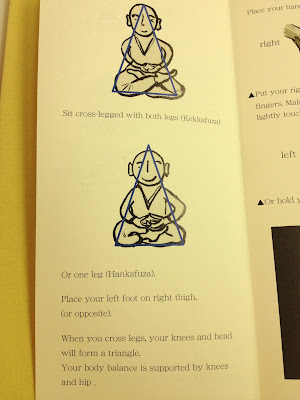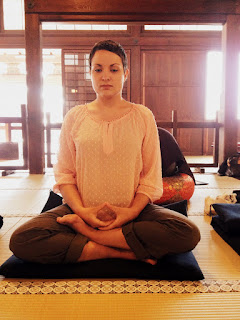"Zazen" meditation literally means "seated" meditation and is central to the practice of Zen Buddhism. Zazen asks practitioners to just sit, suspending any judgement of thought while simply letting all thoughts, feelings, images, and ideas to pass by without becoming attached to or involved in them.
This particular session of Zazen was for foreigners and was held at Kenchoji temple, the highest-ranking Zen temple in Kamakura and the oldest Zen training monastery in Japan. (!!) The temple was completed in 1253 after being founded by a Chinese Zen master who moved to Japan in 1246. Zen monks who are fluent in English host Zazen for foreigners during various months of the year. Before I write more about my Zazen experience, let me show you some pictures of this gorgeous temple.
 |
| The entrance to the temple. |
 |
| One unique feature of this temple is that its main buildings are in a direct line from the entrance. The temple also houses a monastery for those training to be Zen monks. |
 |
| There were beautiful flowers lining the walkway. Most of them had already bloomed, but those that were left were amazing. |
 |
| See?? |
 |
| This is the main gate, built in 1754. |
 |
| These Chinese Junipers are designated as National Treasures because they were planted 750 years ago (wow!) from seeds the founder of the temple brought with him from China. |
 |
| I thought it was funny that this fountain had a sign to clarify. |
 |
| This Buddha hall was originally a mausoleum belonging to the Shogunate and was located in Tokyo. They were moved piece by piece to their present location in 1647. |
 |
| All major public ceremonies are performed in this building, which was built in 1814. It is the largest wooden Buddhist structure in Eastern Japan! |
 | ||
| The painting on the ceiling was amazing. |
 |
| This building was also moved here from a previous location. It was moved from Kyoto, piece by piece. |
 |
| This hall is connected to the side of the above building. This was where our Zazen session was held. |
Zazen started at 1:00pm, where we gathered in the hall and found a seat.
We had picked up this brochure on the way in, and the monks went over it, explaining how to sit, how to place our hands, and how to breathe during Zazen.
Our Zazen lesson consisted of three 15-minute sessions. Fifteen minutes doesn't sound like much, but about 30-seconds into our first session, I was wondering what in the world I had gotten myself into. I could feel my body twitching because it was so hard to keep from moving anything. My mind was cluttered, mostly with thoughts of "I bet it's only been about 1 minute! I have 14 more to go?!" and my foot started going numb.
But by the end of the third session, it was much easier. I had a few moments (I'm talking mere seconds) where my mind seemed completely quiet and it became much easier to sit in Zazen position. Time also went by much faster the third time around.
At the end of our meditation sessions, we were invited to chant a Heart Sutra with the monks.
It was great!
But the best part of the day was the tea ceremony held after Zazen, during which we could ask the monks about anything we wanted. They were all so nice! And they wanted us to fill out forms with feedback about the program so they would know how to make it better for foreigners. In my opinion, it was great just as it was!
 |
| This postcard (and the one below) were gifts from the monk sitting in the chair in the above picture. He is an artist and draws the illustrations for the brochures. :) |
Zazen was a fabulous experience and I'm going to be taking my mom back next month when she comes to visit. If you have any interest at all, I highly suggest you reserve a spot for Zazen at Kenchoji. It is truly a uniquely Japanese experience.
If you'd like to participate in Zazen, please visit this site for more information:
http://www.kenchoji.com/
If you do not make a reservation ahead of time, you may still show up on the day of Zazen to see if room is available. :)
**Big thanks to everyone who made photos available, including fellow participants and the temple monks themselves.**



















No comments:
Post a Comment